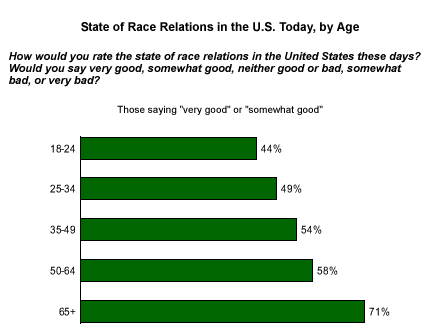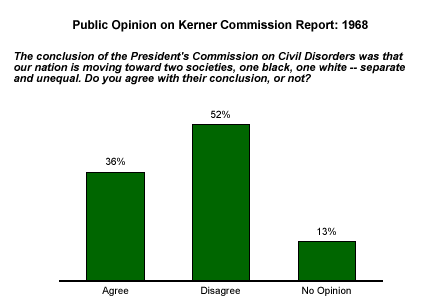Gallup's latest social audit on race relations* asked Americans to evaluate the current state of race relations in the United States. The customary optimism of youth notwithstanding, the results suggest that older respondents tend to feel better about the state of race relations these days. One possible explanation for this is simple -- younger Americans just don't remember the "long, hot summers" of race riots in the 1960s. Harlem. Watts. Newark. Detroit. To younger people, those names don't carry racial overtones, but older Americans still associate them with the darkest hours of the civil rights movement era.

After the tumultuous public school desegregation battles following Brown vs. Board of Education (see "Reflections on the ‘Trouble in Little Rock'" in Related Items), hopes for equality were high among blacks. That optimism rose even further when, in 1964, President Lyndon B. Johnson signed the Civil Rights Act, banning race discrimination in all public accommodations.
Despite the progress represented by the Civil Rights Act -- or perhaps in part because of it -- tensions between whites and blacks continued to run high across America. Indeed, throughout 1964, racial issues were the most commonly mentioned issue when Americans were asked to name the most important problem facing the country. After a white, off-duty police officer shot and killed a black teen-ager in Harlem, race riots broke out on July 18, 1964, leaving one person dead and more than 100 injured. Shortly thereafter, a July 23-28 Gallup Poll recorded a dramatic 60% of Americans mentioning racial issues as the most important problem facing the country (the next most-often cited were international problems, such as the emerging conflict in Southeast Asia, mentioned by just 8% of Americans).
Tensions continued to flare and riots soon followed in other northern cities: Rochester, N.Y., Paterson, N.J., Chicago, and Philadelphia, among others. Racial issues continued to top the list of the most important problem, but by a much smaller margin. But Americans were still well aware of the racial violence. Gallup asked in the fall of 1964, "Have you heard or read about recent violent Negro demonstrations in several northern cities?" Ninety-one percent of Americans said yes. The violence did not appear to help blacks win sympathy among the larger general public in the broader fight for civil rights. An October 1964 poll found 73% of Americans agreeing that blacks should "stop their demonstrations now that they have made their point even though some of their demands have not been met," while only 17% agreed with the alternative statement that blacks "have to continue demonstrating in order to achieve better jobs, better housing, and better schooling."
A July 1965 poll found that nearly half (49%) of Americans expected relations to get worse between blacks and whites. That expectation was borne out as racial rioting intensified. On Aug. 11, 1965, six days of violence erupted in Watts, a section of Los Angeles that has recently changed its name to South L.A. in an effort to exorcise its deadly past. Thirty-four people were killed, 1,000 injured, more than 4,000 arrested, and hundreds of buildings were burned or destroyed. Still, the boiling point didn't come until two summers later, in July 1967, when first Newark, then Detroit exploded in the bloodiest urban riots of the 1960s.
By August 1967, when Gallup asked what Americans thought was the most important problem in the United States, racial issues (including mentions of rioting), along with the Vietnam War, were the dominant issues. In that same poll, Gallup asked the public what it thought could be done to prevent riots from developing in "Negro areas." Americans were somewhat more likely to mention ideas aimed at deterring violence (such as increasing police forces or getting tougher with those who are responsible for the riots) than to mention steps aimed at bettering the conditions of blacks (such as increasing their job and educational opportunities).
In an effort to understand and quell the growing urban violence, Johnson appointed Illinois Gov. Otto Kerner to head the National Advisory Commission on Civil Disorders. The Kerner Commission report, presented in 1968, proposed educational and employment opportunities for inner-city blacks, and warned that the United States was moving toward "two societies, one black and one white -- separate and unequal." When asked their opinion on this characterization in May 1968, 52% of Americans disagreed with the commission's findings, while 36% agreed.

When Dr. Martin Luther King, the central leader of the civil rights movement, was assassinated on April 4, 1968, in Memphis, riots broke out in many U.S. cities. In a special poll of blacks nationwide, conducted in May 1969, Gallup asked, "Do you think there will be riots (by Negroes), in our cities in the months ahead, or not?" Nearly two-thirds (64%) responded yes, 9% said no, and 26% were not sure. In contrast to the larger American public, blacks were more likely to believe the riots helped (41%) rather than hurt (30%) "the cause of Negro rights," while 30% had no opinion or thought they didn't make much difference.
Bottom Line
Owing to a wholesale attitudinal change that occurred between the late 1960s and early 1970s, a fragile peace settled in America's inner cities. Several recent events have threatened that peace. The most lethal was in 1992, when a black man, Rodney King, was brutally beaten by police in Los Angeles. When the police officers were acquitted in court, three days of riots, looting, and fire damage followed, resulting in 52 deaths. Despite such events, current public opinion reflects the legal, educational, economic, and moral groundwork has been laid since the 1960s in an effort to achieve better race relations in the United States.
*Gallup conducted 1,044 telephone interviews from Dec. 9, 2002, through Feb. 11, 2003, with a randomly selected sample of adults in the continental United States. We interviewed roughly equal numbers of black and white respondents, permitting more reliable estimates of black opinion than would be possible in a standard national sample of a similar size. For our total sample of 1,044, one can say with 95% confidence that the margin of sampling error for percentages is not greater than ±5%. The parallel margins of sampling error are ±6% for the sample of 505 white respondents, and ±6% for the sample of 501 black respondents.
